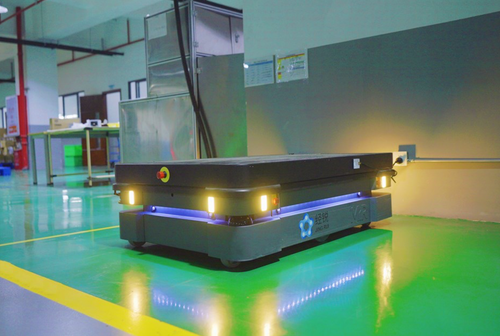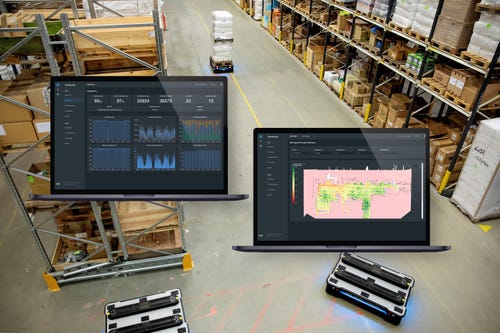How to Build a Better Autonomous Mobile Robot
Here are the engineering details behind the creation and operation of an autonomous robot fleet.
August 30, 2023

Autonomous mobile robots (AMRs) have become an important tool for optimizing manufacturing and warehouse operations. These robots are also being deployed in healthcare, retail, and other nonindustrial settings. We caught up with Rishabh Arora, team lead for application engineering at Mobile Industrial Robots Americas – also known as MiR. Arora explained the engineering at the heart of autonomous mobile robots.
Tell us about the robots you build.
Rishabh Arora: We build autonomous mobile robots that safely, easily, and cost-effectively transport materials within facilities from point A to point B. They are easy to deploy and control with simple mapping capabilities that enable companies to set up missions without programming experience. Being autonomous, these robots can move around humans and other obstacles in their path while calculating the best route to their target.
The payload capacity ranges from 100kg (220 pounds) to 1350kg (2976 pounds). Our robots are highly flexible and customizable for easy implementation and scalability. The flexibility is possible because of the top modules we build for the robots, such as a hook to tow carts, a pallet lift to transport pallets, and a shelf carrier to move shelves around. There are actually hundreds of different top modules available from third-party suppliers for our robots such as a Universal Robot (UR) arm mounted on a MiR robot or roller top modules to transfer loads from the conveyors.

What are some strategies to improve uptime?
Arora: To enable the best uptime possible for your AMRs, leverage the options built into the robot’s software that lets users optimize the map and mission setup. You can plan as much as possible from the beginning or start with a basic setup and then gradually improve your setup in steps. For example, we have different zones available during mapping such as directional zone and limit robot zone. We also have mission actions such as Try/Catch, which allow the robots to retry an action or do an alternate task if the main task fails for any external reason. Test the setup by running the missions created. Tests must include events that could occur in everyday operations, such as accidents, blocking obstacles, incorrectly loaded cargo, and WiFi disconnection.
Ensuring AMR uptime also requires a robust site:
Have a stable WiFi connection that is able to localize well everywhere the robots operate
Ensure the missions do not run for too long. Long missions make larger mission logs that will eventually slow down the root and make it more difficult to troubleshoot
Non-movement actions are not repeated without pauses in loops. For example, a mission that keeps evaluating an If statement in a loop without pause between iterations will fill up the mission log quickly and will eventually slow down the robot. Implement a Wait action in your loop to avoid issues like this. There is an action rate limiter which reduces the number of actions that can be executed per second if too many actions are executed in a short time span. This reduces the effect of missions that execute many actions quickly, but we recommend avoiding this altogether to ensure stable behavior.
Do not use special characters in your map, map components, or mission names
Our fleet software also manages the robots’ battery charging in between the missions to ensure high uptime.
MiR’s new analytics software, MiR Insights, helps improve uptime with error monitoring and data analysis. MiR Insights answers questions such as:
What was the overall mission effectiveness of my robot fleet this week?
Do we have any specific areas in our production where our robots encounter recurring challenges?
How have the changes we implemented on the factory floor last month impacted robot throughput?
This link gives more information on how the answers MiR Insights uncovers help optimize performance and uptime: https://www.mobile-industrial-robots.com/solutions/mir-accessories/mir-insights/

How do you prevent robot failures?
Arora: Companies can prevent robot failure by ensuring the map and mission setup are robust enough to handle any potential issues such as the goal position being blocked. We provide in-person training and free online training as well and cover examples of a robust setup using features within the software. We also have guides with actual examples of a robust map and missions.
What is a robust mission for mobile robots?
Arora: A robot mission is one that has fallback options built in. For example, if the robot’s goal position is blocked, it should be able to drop off its load at another position instead of erroring out.

How does safety contribute to robust robot performance?
Arora: Safety is our top priority when designing the robots. MiR robots have Lidars and #D cameras to safely interact with humans and objects in their environment. There are many other features built-in for safety, using SICK safely PLC, such as cutting off power to the motors and applying brakes if the safety field sets around the robots are infringed. Safety is so important to MiR and our customers that we have spent the last few years preparing our robots for TÜV Rheinland [tuv.com] certification in accordance with the ISO 13849-1 industry standard.
This respected third-party testing and certification organization awarded our MiR600 and MiR1350 AMRs with 13 certifications, giving independent assurance that the safety functions are implemented and meet international standards. With more customers than ever expecting relevant third-party certifications to be in place, we are continually committed to going beyond the basic requirements and helping push the robotics industry to a higher standard by expanding the use of these types of certifications.
Explain the type of training that can help users make their robot missions more robust.
Arora: Training is critical in every stage of the process, whether a worker is responsible for deploying the robots managing them, or simply working alongside them. MiR offers free, comprehensive training through our online MiR Academy. These short courses – close to 7 minutes or less with 2-3 minute videos – enable trainees at any level to finish each segment with fewer changes or interruptions during the workday.
We also provide in-person specialist and expert training throughout the year, both onsite and in our offices in Novi, Michigan, and San Diego. These classroom-type courses offer unparalleled experience working in a safe environment with AMR experts. Our trainers encourage their trainees to tackle challenges with our robots and reach mastery by trying, failing, and readjusting. The trainees come out of the experience feeling more confident in their own abilities and ready to work more independently with the robots.
Customers can also access training guides at any time, helping to familiarize – or refamiliarize – themselves with the skills they need to best manage their AMR fleets.
About the Author(s)
You May Also Like





